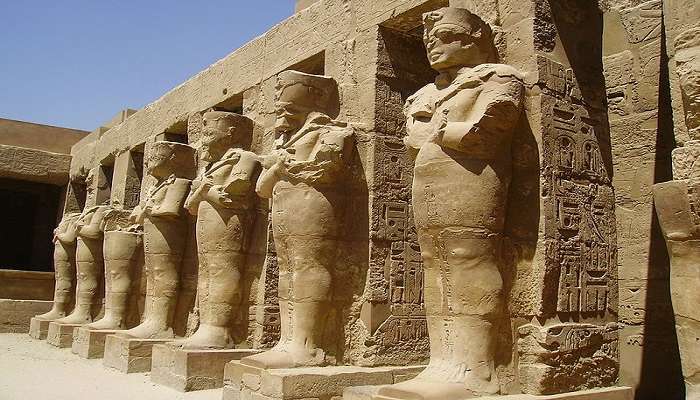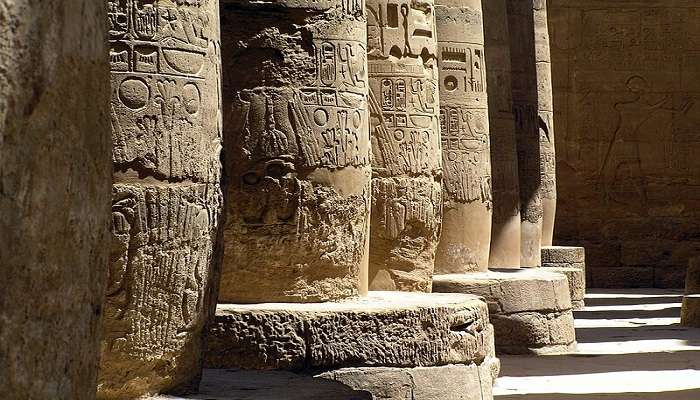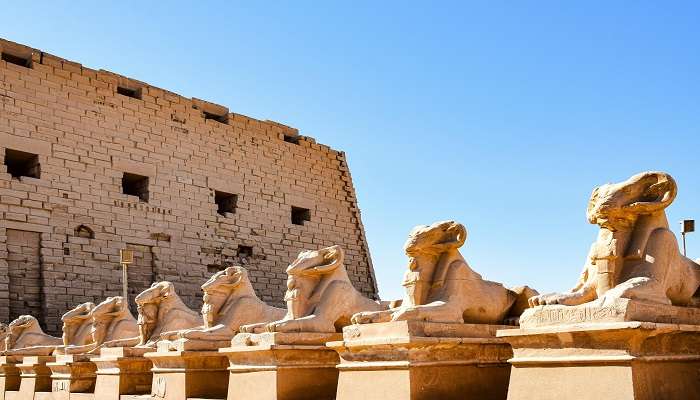Karnak Temple Is The Perfect Egyptian Spiritual Retreat

The Karnak Temple, located on the east bank of the Nile River in Luxor, is a massive and awe-inspiring ancient Egyptian temple. Built over 4,000 years ago, it was used to worship the god Amun-Ra and was the most important place for religious activities in Thebes. As soon as you enter the temple, you can see huge statues, tall obelisks, and detailed hieroglyphs that tell stories about pharaohs and gods. You can admire the Great Hypostyle Hall, check out the Sacred Lake, and think about the meaning of each amazing building. Hence, a visit to the Karnak Temple will take you back in time.
About Karnak Temple

The Karnak complex in Egypt is a vast open site that includes the Karnak Open Air Museum. It’s the second most visited historical site in Egypt, after the Giza pyramid complex near Cairo. The complex has four main parts, but only the largest one is currently open to the public. The term “Karnak” usually refers to the Precinct of Amun-Re, which is the part most visitors see. The other three parts—the Precinct of Mut, the Precinct of Montu, and the dismantled Temple of Amenhotep IV—are not accessible to the public.
What makes Karnak unique is its long history of development. Construction of temples there began during the Middle Kingdom and continued into Ptolemaic times. Around thirty pharaohs contributed to the buildings, resulting in a complex with diverse features. While individual elements may not be entirely unique, the sheer size and number of features set Karnak apart. The deities represented range from ancient ones to those worshipped much later in Egyptian history. Despite being partially destroyed, Karnak also contains evidence of adaptations by later cultures, such as Coptic churches built within its structures.
Must Read: Kom Ombo Temple
History Of Karnak Temple

The history of the Karnak temple is intricately tied to the history of Thebes and its fluctuating prominence in ancient Egyptian culture. Initially, Thebes was not a significant city before the Eleventh Dynasty, and early temple structures were modest, dedicated to local deities such as the Earth goddess Mut and Montu. Invaders destroyed early constructions, but the oldest artefact from the site, a small column from the Eleventh Dynasty, references Amun-Re, the tutelary deity of Thebes, whose name means “hidden” or “the hidden god.”
During the Eighteenth Dynasty, Thebes became the capital of a unified Egypt, leading to significant construction in the Precinct of Amun-Re. Almost every pharaoh of this period contributed to the temple. Notable projects include Thutmose I’s enclosure wall, Hatshepsut’s twin obelisks (one of which remains the second-tallest standing ancient obelisk), and her Red Chapel. The Great Hypostyle Hall, which features 134 massive columns, likely began during the Eighteenth Dynasty but saw significant work under Seti I and Ramesses II of the Nineteenth Dynasty. The last significant addition to the temple’s layout was the First Pylon and enclosure walls built by Nectanebo I of the Thirtieth Dynasty.
By 323 AD, Roman emperor Constantine the Great had recognised Christianity. In 356 AD, his successor Constantius II ordered the closure of pagan temples across the Roman Empire, which included Egypt since its annexation in 30 BC. Consequently, Karnak was largely abandoned, and Christian churches were established within its ruins. The most notable example is the reuse of the Festival Hall of Thutmose III, where Coptic inscriptions and saintly decorations remain visible.
Visiting The Karnak Temple Complex

1. Precinct Of Amun-Re
The Precinct of Amun-Re is the most significant part of the temple complex, dedicated to Amun-Re, the main god of the Theban Triad. It includes many giant statues, like a 10.5-meter (34-foot) tall figure of Pinedjem I. The sandstone for the temple’s columns was brought from 100 miles (161 km) away. It also has a giant obelisk weighing 328 tons and standing 29 meters (95 feet) tall.
2. Precinct Of Mut
Located south of the Amun-Re complex, the Precinct of Mut is dedicated to the mother goddess Mut, who was seen as Amun-Re’s wife. This area has smaller temples and a crescent-shaped sacred lake. Although parts of the temple were reused elsewhere, a team from Johns Hopkins University, led by Betsy Bryan, restored and opened it to the public. They found 600 black granite statues here. This precinct is likely the oldest part of the site.
A “porch of drunkenness” built by Pharaoh Hatshepsut was discovered in Luxor. This ties into a myth where Ra, the sun god, created Sekhmet to punish mortals. To stop her from destroying humanity, Ra tricked her into drinking beer mixed with pomegranate juice, making her drunk and transforming her into the peaceful Hathor.
3. Precinct Of Montu
The Precinct of Montu is dedicated to Montu, the war-god son of Mut and Amun-Re. It’s north of the Amun-Re complex and is smaller. This area is not open to the public.
Suggested Read: Best Places To Visit in Luxor Egypt
Opening Hours, Entrance Fees, & Best Time To Visit

The Karnak Temple opening hours welcome visitors daily from 8 am to 5 pm, except on Fridays when it opens at 11 am and closes at 4 pm. Regular admission costs 65 EGP, while students with valid ID pay 35 EGP. For an optimal experience, plan your visit during the cooler months (from October to April) to explore this awe-inspiring historical site comfortably.
Further Read: Avenue Of Sphinx
Karnak Temple is a breathtaking ancient site that leaves visitors in awe of the architectural mastery and rich cultural heritage of ancient Egypt. Its colossal columns, intricate hieroglyphics, and the sheer scale of the complex are a testament to the ingenuity and grandeur of the pharaohs who ruled over this great civilisation. Book your trip to Egypt now and discover the hidden stories of this amazing place. Explore the wonderful Karnak Temple and create unforgettable memories.
For our editorial codes of conduct and copyright disclaimer, please click here.
Cover Image Credit: Tizianok for Wikimedia Commons
Frequently Asked Questions About Karnak Temple
Why is the Temple of Karnak so famous?
The Karnak Temple Complex near Luxor, Egypt, is famous for encompassing a mix of temples, towers, chapels, and other structures. Karnak was where people worshipped the 18th Dynastic Theban Triad, led by the god Amun. In 1979, Karnak, along with the rest of Thebes, was recognised as important and added to the UNESCO World Heritage List.
Which god is the Karnak Temple dedicated to?
The Karnak Temple Complex was dedicated primarily to the god Amun, who represented creation, fertility, and kingship. Amun was part of the Theban Triad, along with the goddess Mut (his consort) and their son Khonsu.
What is the mystery of the Temple of Karnak?
There isn't one specific overarching mystery surrounding Karnak. However, the complex is so vast and has seen so much construction over time that archaeologists continue to uncover new secrets and hidden chambers.
Is Karnak the largest temple in the world?
Yes, the Karnak Temple Complex is considered the largest religious building ever constructed, covering over 200 acres
Who destroyed the Karnak Temple?
The temple complex faced various challenges over centuries, including natural decay, religious changes, and invasions. However, it wasn’t entirely destroyed. Some parts suffered damage during different periods, but much of it remains standing today.
People Also Read:
Mangaladevi Temple Chamundeshwari Temple Vellayani Devi Temple

As a Travel Content Writer, I live to conquer the world of globetrotting with words. With my unquenchable thirst for storytelling, I believe that my words will inspire you to travel around the world’s breathtaking landscapes. As for me, I am an unapologetic selenophile, who loves to wander around in a starry night!











